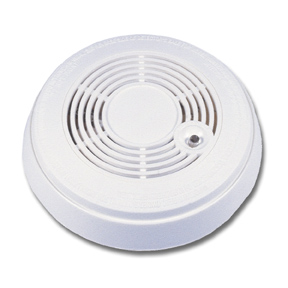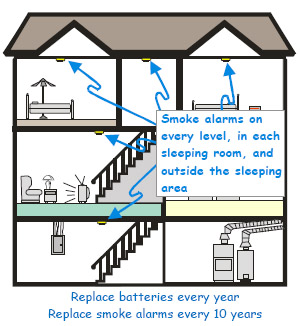 A working smoke alarm provides vital early warning and extra time to escape if there is a fire in your home. Every house should have at least one working smoke alarm. Basic alarms cost under $10 and can be purchased at local hardware or variety stores.
A working smoke alarm provides vital early warning and extra time to escape if there is a fire in your home. Every house should have at least one working smoke alarm. Basic alarms cost under $10 and can be purchased at local hardware or variety stores.
If you or someone you know needs a smoke alarm and cannot afford to purchase or install it, the William Cameron Engine Company may be able to help. Call the department at 524-2295 for more information.
Remember to Change Alarm Batteries Yearly and Test Alarms Weekly
Your smoke alarm can save you only if it is in proper working condition. Smoke alarms require simple but regular maintenance.
- Test your smoke alarm each week using the test button.
- Every six months, open the case and gently vacuum the inside to remove dust from the sensor. If the smoke alarm doesn’t open, vacuum through the holes.
- Change the battery every year. A good way to remember to change your smoke alarm battery is to change it with the move to daylight savings time each year.
- Replace the battery in your smoke alarm if the low battery warning sounds — an intermittent bleep — and replace the battery with a new one as soon as you can.
- The useful life of some kinds of smoke alarms is about 10 years. If you still hear a low battery warning even after replacing an old battery with a new one, the entire alarm may need to be replaced.
- Some smoke alarms get power directly from your home’s electrical system. Such “hard-wired” alarms still require a back-up battery in case of power failure — an event that can happen in a fire. If you have hard-wired smoke alarms replace your back-up batteries yearly.
 Guidelines for Installing Smoke Alarms
Guidelines for Installing Smoke Alarms
- Always put smoke alarms where you will be able to hear them throughout the home, particularly when you are asleep or when doors are closed.
- If your home has only one level, install the alarm between the living area and bedrooms.
- If your home has more than one level, install one alarm at the bottom of the staircase and further alarms on each landing.
- Install smoke alarms on the ceiling, as near as possible to the center of the room, hallway or landing. The smoke alarm should be at least 12 inches away from any wall or light fitting.
- Make sure you can reach your smoke alarm easily to test it each week – avoid installing it directly over a staircase.
- Follow the manufacturers’ instructions on how to fit your smoke alarm and change the battery.
Where not to install a smoke alarm
- Don’t install your smoke alarm in or near to the kitchen or bathroom as it could be set off accidentally by cooking fumes and steam.
- Don’t install your smoke alarm in a garage where it could be set off accidentally by exhaust fumes.
- Don’t install your smoke alarm on damp or dusty surfaces or false ceilings as there is a risk it will fall down.